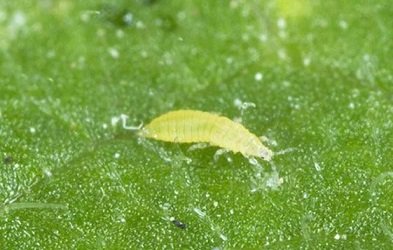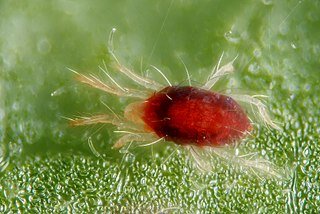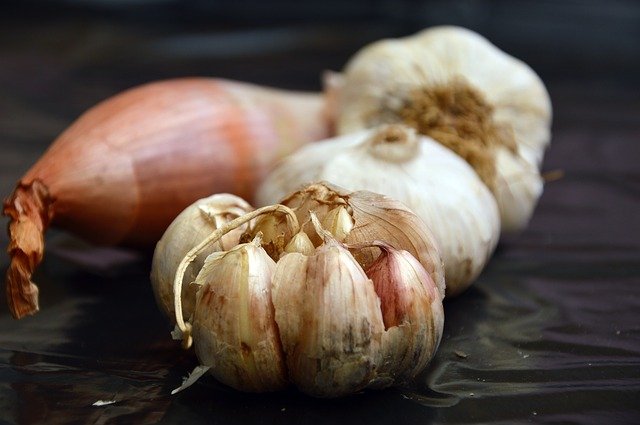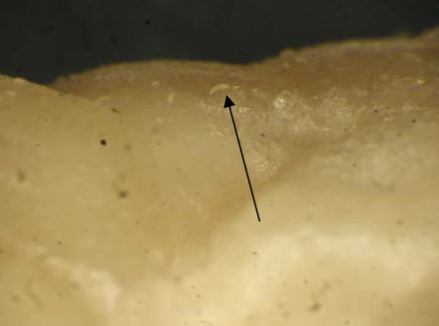Garlic has become a beloved vegetable and Americans are even growing garlic indoors for scapes or bulbs. But after waiting for 8 – 9 long months, you may find your garlic crop is damaged and made unusable by the uninvited guests – “Garlic Pests“.
Common Pests for Garlic are Onion Thrips, Dry Bulb Mites, Onion Maggot, Red Spider Mite, Stem and Bulb Nematodes, Allium Leaf Miner, Tobacco Caterpillar, Leek Moth, etc.
A host of insects are known to be pests to garlic and the related Allium family members (onions, leeks, shallots, etc). Their effects and damages range from damage to bulbs, leaves, and even split stems. Poor garlic harvests in the USA are mostly attributed to garlic pests and their negative effects.
These pests impact the output and quality of harvested garlic making it vital to identify these pests and devise an effective pest management scheme.
Below are the details of garlic pests and ways to control them.
1. Onion Thrips (Thrips tabaci)
Onion Thrips are the most common and widespread pest that affects garlic and other members of the Allium species of vegetables.

These small insects range from a size of 1 to 1.3 mm. Apart from being capable of high damage to developing garlic plants, they can also act as a vector for the dissemination of disease.
How Onion Thrips Affect Garlic?
Thrips normally cause serious damage to garlic plants.
They get attached to garlic leaves and use their mouthparts to rip and pierce leaves. They then secrete digestive enzymes into these holes and suck up the juices that ooze out from these injuries.
Leaves are left with white or silvery areas.
The effects of Thrip on Garlic are:
- Reduced green leaf area for photosynthesis
- Leaf injuries act as an entrance for pathogens
- Open wounds tend to allow excess transpiration of water from the garlic plants
How to control Onion Thrip?
- Opt for thrip resistant or tolerant garlic variants
- Do not plant successive crops of garlic or other Thrip host plants like onion, cabbage, cotton, pumpkin, melons, etc.
- Use sprinkler systems instead of surface irrigation systems
- Practice good field sanitation (destroying old plant remains and produce)
- The use of heavy mulch can dissuade large thrip populations
2. Dry Bulb Mites (Eriophyes tulipae or Aceria tulipae Keifer)
Dry Bulb Mites are called the Eriophyid mite. They are common garlic pests that cause irreparable damage to garlic crops. The adult Dry Bulb mites are 0.25mm in size. They have a cylindrical shape with tapering ends.
Many times, bulb mite infestations are so small and incognito that it goes unobserved and untreated. Dry bulb mites are dangerous since they can be transmitted through the air due to their low body weight.
How do Dry Bulb Mites affect Garlic?
These mites reside in between the garlic cloves and emerging leaves, their presence is usually evident in the form of “galls”. Galls are external outgrowths arising from leaf surfaces and are the animal equivalent of tumors or worts.
The effects of Dry Bulb Mites on Garlic are:
- Yellowing of leaves or light-green coloring
- Leaves do not emerge properly from bulbs, resulting in twisted leaves
- Bulb development is stunted and they lose their firm texture
- Garlic cloves may shrivel up
How to control Dry Bulb Mites?
- Avoid consecutive cultivation of onion and garlic plants
- Do not plant garlic after Cole crops like cauliflower, cabbage, broccoli, kale, etc. These are members of the Brassica family.
- Plant clean garlic cloves as bulbs may bear dry mite infection if stored for long periods
- Flood irrigation or heavy rain before planting can limit mite numbers present in the soil
3. Onion Maggot (Delia antiqua)
Onion maggots are the larval form of the onion fly. These maggots are disruptive to any bulb-producing plants including garlic. The onion fly chooses a host plant and lays groups of elongated white eggs on shoots, leaves, and even roots of preferred host plants.
Eggs hatch within 3 to 8 days and feed vigorously for 20 days before entering the next phase of their life cycle.
The larvae are white and cylindrical in shape. These larvae tend to keep together and can attack the same bulb.

How Does Onion Maggot affect Garlic?
These larval forms are the most destructive. They use their hooked mouths to enter bulbs and cause large cavities.
The effects of Onion Maggot on garlic are:
- Yellowing of leaves
- Rotting of garlic bulbs
- Reduction in bulb development
- Damage and death of seedlings
How to control Onion Maggot?
- Opt for efficient crop rotation (follow garlic crops with non-Allium crops)
- Leave considerable space between plants during planting
- Clear out all plant debris of previous cultivations
- Soil tilling can destroy larvae by leaving them visible to predators
- Observe the garlic crops and keep removing infected plants
Biological Management of Onion Maggot
Increase natural onion maggot predators: spiders, ground beetle, and rove beetle by providing grass mulch for them to seek refuge.
4. Red Spider Mite (Tetranychus urticae)
Red Spider Mites also goes by the name of Two-Spotted Spider Mites. These mites belong to the acari group and have an unsegmented body with several arms.

The red spider mites are very small and hence are almost invisible. They just appear as red or green spots. Adult females grow to a maximum size of 0.4 mm. They lay their eggs on the leaves of host garlic plants.
How Red Spider Mite affects Garlic?
Red spider mites puncture the underside of leaves and feed on the sap cell by cell. These mites are mostly present in the thousands and hence effects are on a larger scale. This means they can spoil a full garlic crop.
The effects of Red Spider Mite on Garlic are:
- Loss of photosynthetic capability of the plant
- Leaves lose green coloring and fall off
- Leaves are left with thousands of wounds/lesions and spots
- The formation of webs under or on leaf surfaces is proof of a red mite infestation
How to control Red Spider Mites?
- Water spraying can wash off red spider mite swarms
- Catch infestations early by checking specifically for red spider mites and silk webbing under leaves
5. Stem and Bulb Nematodes (Ditylenchus dipsaci)
Nematodes that affect garlic are minute roundworms that are 1.5 mm long. When present in large numbers, nematodes can damage an entire garlic plant from leaves to the root system. They live in leaves, or in bulbs between outer clove wrappers.
How do Nematodes affect Garlic?
Nematodes cause stunted growth in a variety of Allium family members including house plants in some cases. Stems of garlic plants become swollen called “spikkles” when nematodes affect this region.
The effects are:
- Nematodes feed on cell sap, putting individual cells in distress and danger
- Leaves lose their green color and become yellow instead
- Garlic bulb wrapping becomes loose offering no protection to bulbs from the elements
- Infected tissues swell, split, and die
- Garlic plants experience overall stunted growth and reduced harvests
How to control Stem and Bulb Nematode?
- Field sanitation is mandatory
- Crop rotations plans of 3 years are ideal, nematodes are starved of food during the 3-year gap (also, nematodes are extremely host-specific pests)
- Disinfect bulbs by soaking them in a water and formalin solution at 110 to 115℉
- Fumigate fields before planting garlic and other potential host plants
- Low humidity and cooler temperatures are known to be unfavorable conditions for nematode reproduction
- Do not plant bulbs that appear to be infected by nematodes
Soil Requirements of Garlic – Which soil is best for Garlic Growing?
6. Allium Leaf Miner (Phytomyza gymnostoma)
The Allium Leaf Miner or Onion Leaf Miner is a leaf-eating fly. It poses an extreme threat to garlic plants in its larval form.
At the larval stage, these white to yellow worms can measure a maximum of 8 mm in length.

It progresses into dark-brown, oval pupae and then develops into a grey to black-colored fly.
The leaf miner mines the leaf by eating it. It is easy to identify them as leaves are shrunken as they are eaten. The Allium leaf miner takes pleasure in attacking garlic and onion plants during the spring season.
How Allium Leaf Miner affects Garlic?
The damage caused by the larva of leaf miners has detrimental after-effects. These include leaves becoming curly, weak, and evidently distorted. The plant and bulb do not grow properly.
The effects are:
- The feeding of adults causes a streak of white dots on leaves
- Intense heavy leaf miner infections leave garlic plants at risk of bacterial and fungal infections
How to control Allium Leaf Miner?
- Use row covers to reduce the chance of eggs being laid on garlic plants
- Observe plants for Allium leaf miner eggs, larva, pupa, and adult flies. This will alert you of a possible infestation
- Planting certain plants before garlic can reduce leaf miner numbers. They include: mustard, radish, and rapeseed
- Always use pest-resistant garlic if available
7. Tobacco Caterpillar (Spodoptera litura)
The Tobacco Caterpillar also known as the Tobacco Cutworm develops into a nocturnal moth. It affects more than just tobacco, it also affects garlic. Although these pests are not notoriously prevalent in the USA, they can be destructive if present.
These pests are most damaging in the larval form but impact in the adult moth form as well.
How does Tobacco Caterpillar affect Garlic?
Tobacco Caterpillar feeds heavily upon leaves, destroying all matter in their path. When pupae develop into adult moths, they continue to feed off the remainder of the leaves.
The effects of Tobacco Caterpillar on Garlic are:
- Damaged leaves with considerably large holes
- Reduction in photosynthesis as leaves turn brown (loss of chlorophyll)
- The overall growth of leaves and bulb is poor
- Damage along stems and leaf midribs
How to control Tobacco Caterpillar?
- Make it a habit to practice good field sanitation (removal of plant waste and soil preparation routines)
- Crop rotation – you should alternate between garlic and non-host plants such as cereal crops and Cole plants
- Grow garlic with plants that repel tobacco caterpillars. These include basil and marigold.
- Till soil well in advance to expose pupae, resulting in death
- Set up a light trap to attract and draw away adult moths
Biological Management
- Use bird perches to attract natural tobacco caterpillar predatory birds
- Increasing numbers of predatory insects such as wasps, dragonflies, spiders, praying mantis, etc. may improve in controlling them.
8. Leek Moth
Although not usually present in North America, Leek Moths can destroy a crop of garlic. Not only do they affect garlic, but they also pose a threat to biodiversity.
A worrying factor is that the leek moth lacks any known natural predator.
How Leek Moth affects Garlic?
- Leek moth larvae feed on leaf tissue and occasionally on garlic bulbs
- A tunneling mine pattern is observed on garlic leaves
- Extensive leaf damage can kill the plant
How to control Leek Moth?
- Use pheromone traps
- Trap cropping attracts leek moths, and as a result, they lay their eggs on the trap crop instead of on garlic
- Remove and destroy old plant debris
- Practice plant rotation
What insects does garlic repel?
Garlic is quite a potent vegetable with a strong and unique smell. It is no surprise that it acts as a deterrent to certain pests.
Garlic generally helps to keep away weevils, aphids, Japanese beetles, and fruit tree borers.
This makes it beneficial to have garlic in the garden near plants that are vulnerable and attractive to the above insects.
Conclusion
Garlic is an easy-going plant with minimal requirements. The presence of common garlic pests can make a lot of your effort go waste. Thus it is vital to know about them to keep them under control.
References


